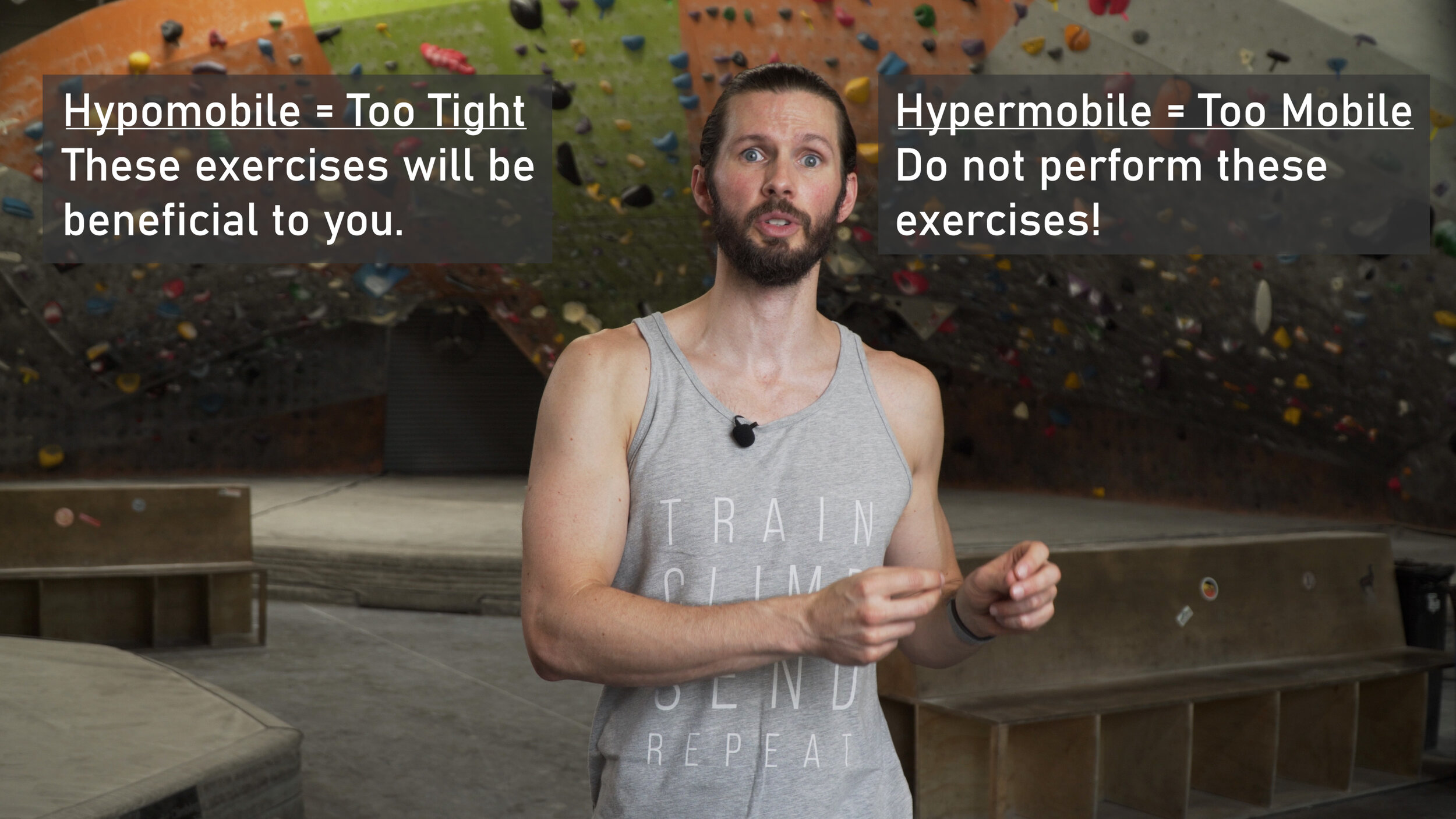How to Increase Shoulder Mobility for Climbers
Hooper’s Beta Ep. 93
INTRODUCTION
In this video, we are going over a quick shoulder mobility routine designed to improve functional mobility and fix or prevent GIRD (glenohumeral internal rotation deficiency)
But before we get started I need to make one thing clear: you need to watch our video on testing shoulder mobility FIRST, before you decide to start this routine. That video will help determine if you have hypomobile shoulders, and thus would benefit from this video, or hypermobile shoulders, in which case you should not perform these exercises.
THE ROUTINE
In this routine, you may find some stretches are more necessary for you than others. Or, you may notice a few are super easy! It is OK to focus more on the stiff areas and ignore ones where you already have great mobility.
Note: There are, of course, other effective shoulder stretches. But this is a simple, easy program with minimal position changes that can be done in a short amount of time. I’ve put together a chart to help you follow along, and now let’s go through the exercises!
Thoracic Extension on Foam Roller
For this you’ll want to lie on the ground with the foam roller across your mid / upper back. Support your head by clasping your hands across the back of your head. Lift your butt up off of the ground, and roll back and forth throughout the mid back region. Perform for 1-2 minutes.
Pectoral Stretches (hands low, 90/90, and overhead)
Here you can use a door, corner of a wall, or a solid post if needed. I recommend doing a 2 handed version for max efficiency, but if you only have 1 sturdy post around, a single-arm version is fine.
Start with hands down low, about 45-60 degrees out to your side, and fingers pointing down and out. Elbows should be slightly bent. Step forward with one leg until you feel a gentle stretch across your chest and/or shoulders. Hold for 30-45 seconds, then move your hands up until they are in the 90-90 position (90 degrees of elbow bend, shoulders at 90 degrees out to the side). Hold for 30-45 seconds, then move your arms up to an overhead position (about 120 degrees of shoulder abduction). Fingers should now be pointed up and out, elbows slightly bent. Hold for 30-45 seconds.
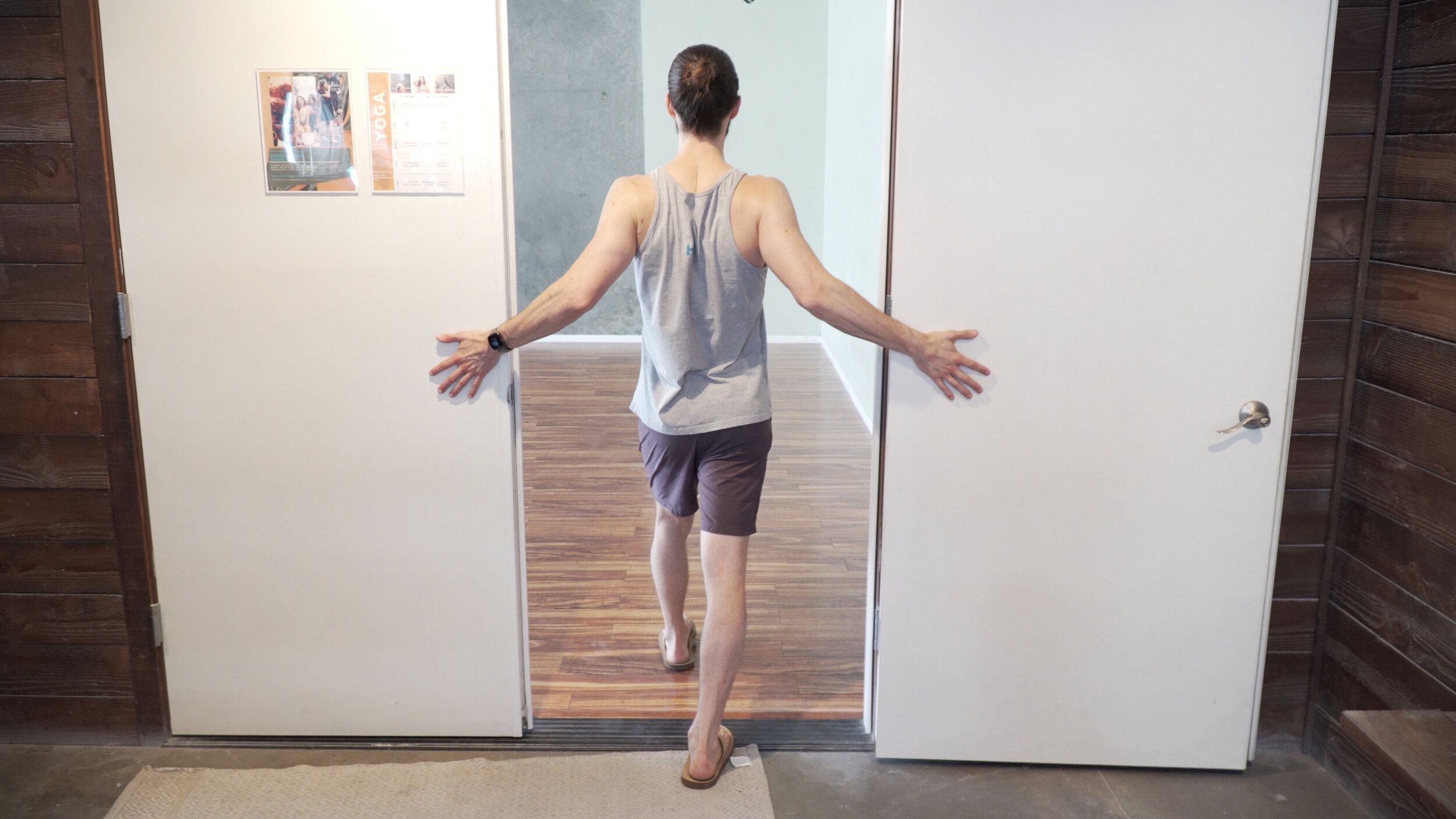
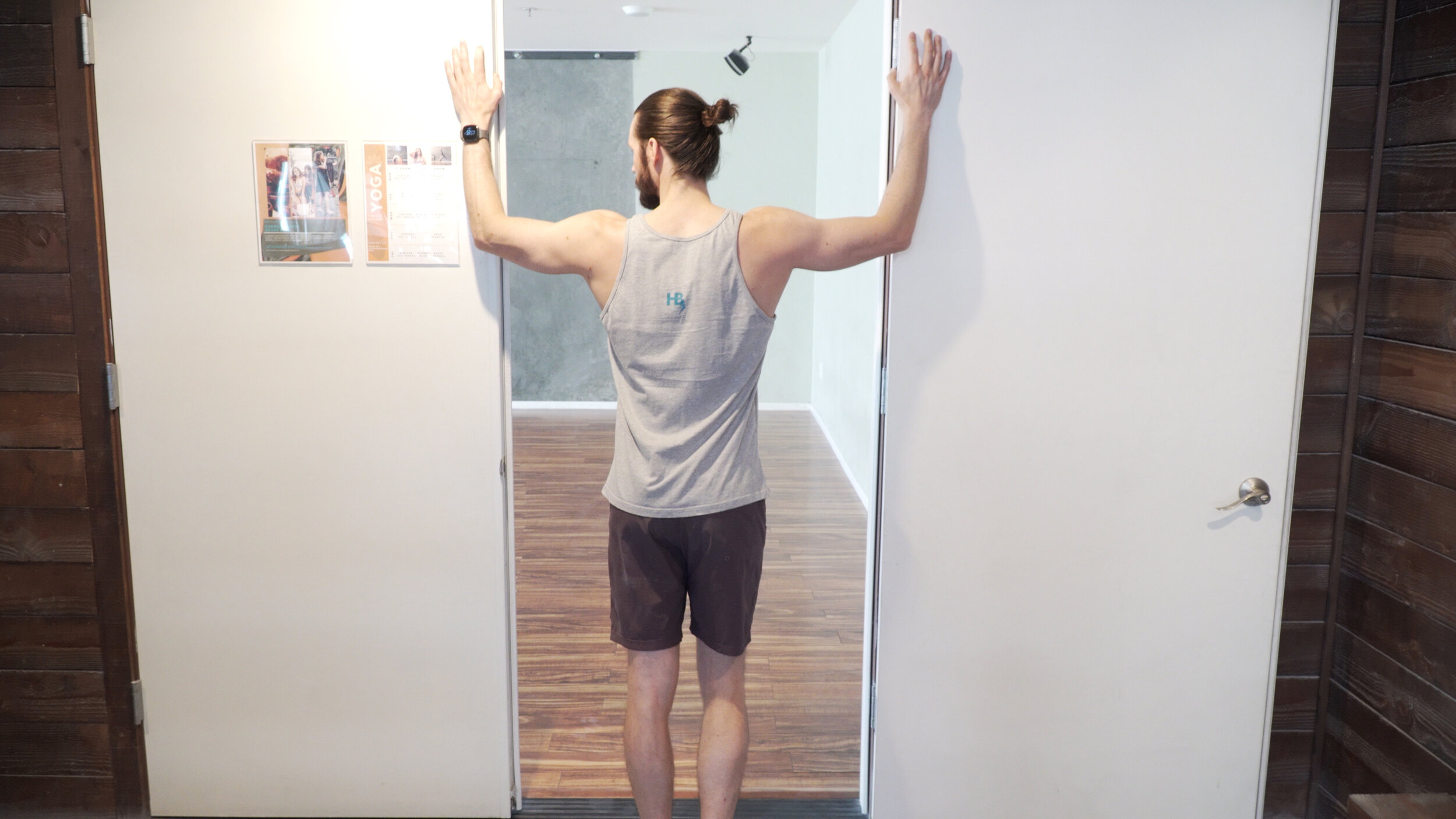
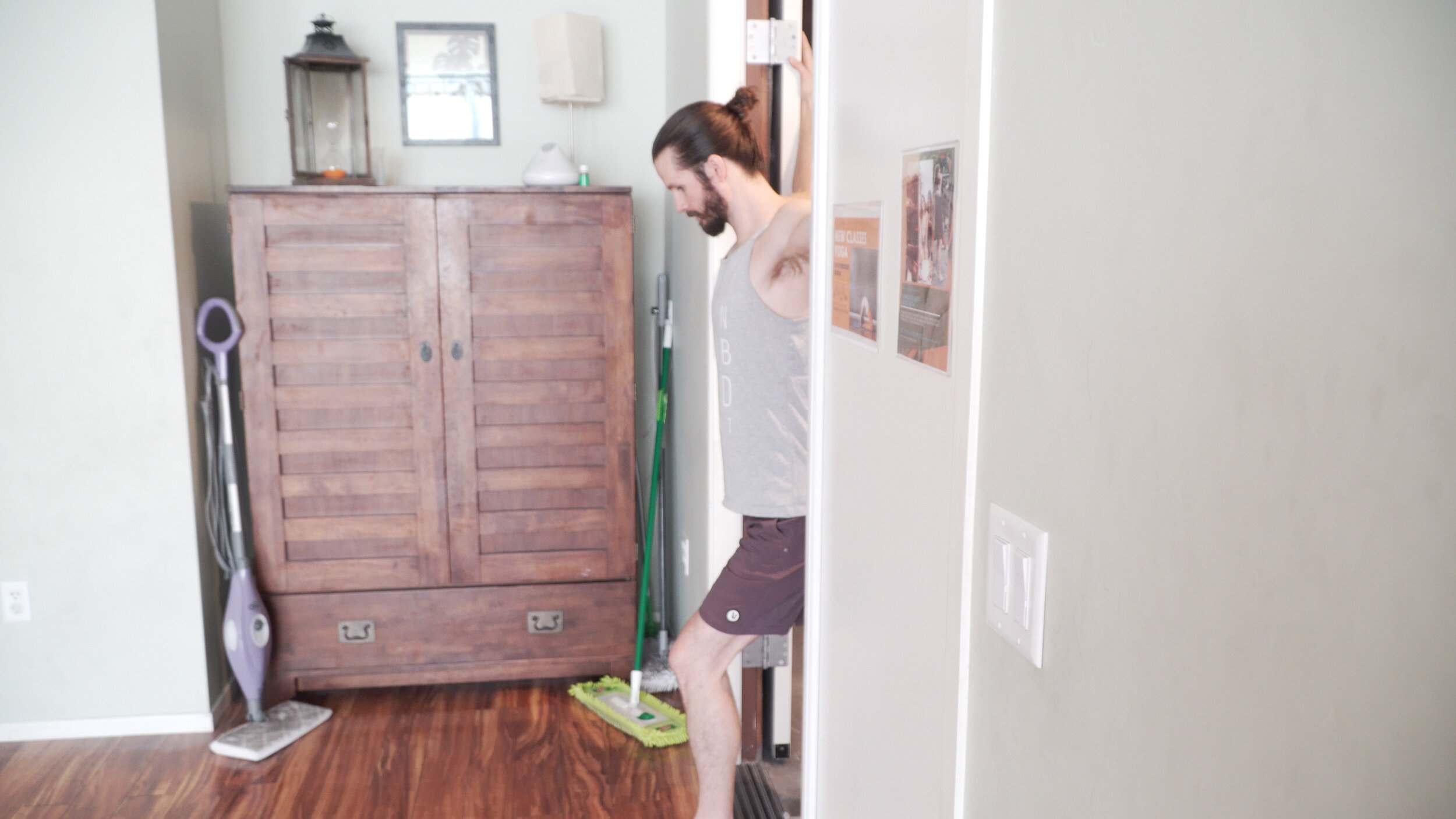

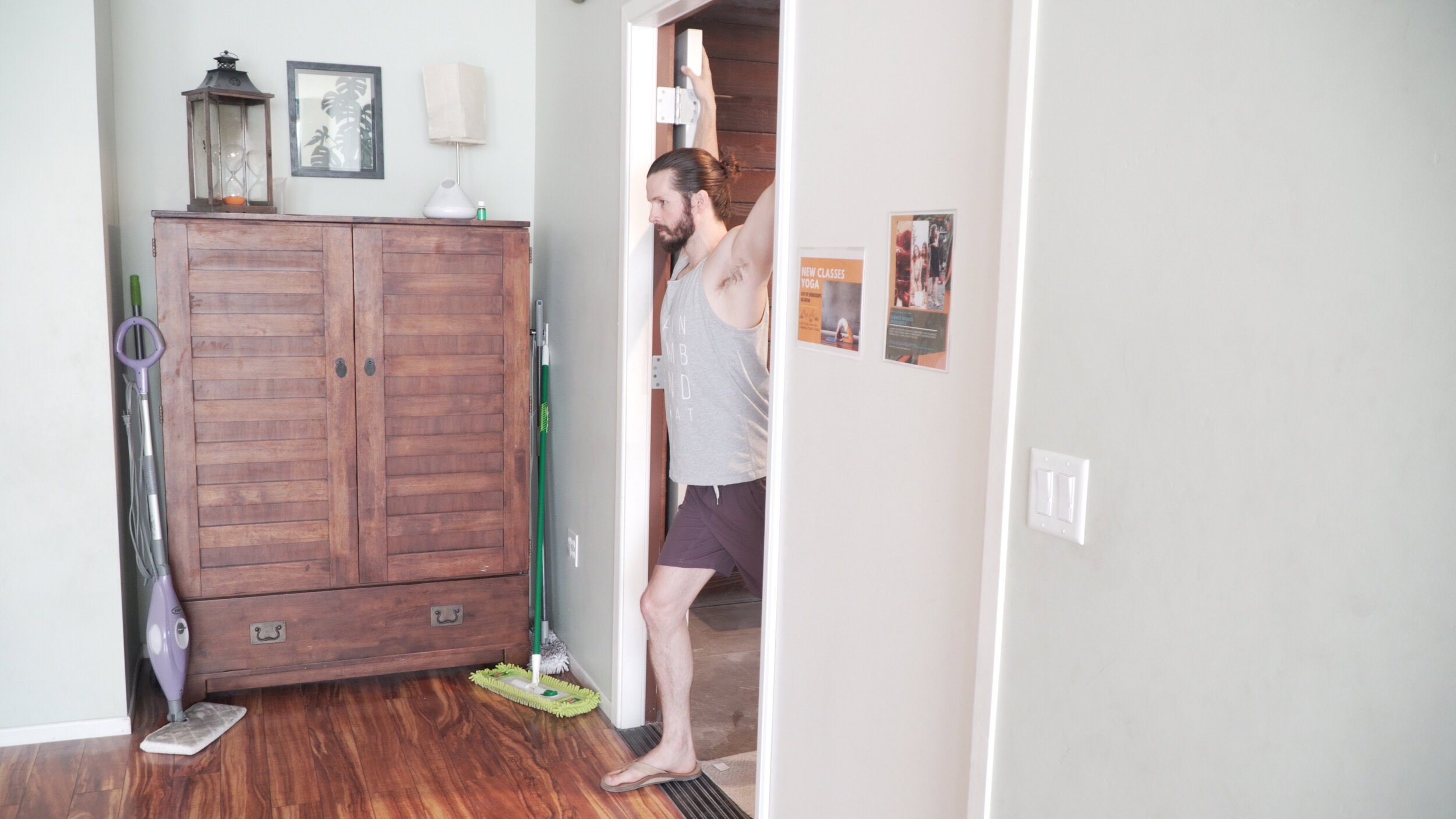
Latissimus Dorsi Stretch
For this, a doorway or post is once again very useful. Grab the post or door frame with your thumb *up*. This is key to prevent shoulder discomfort and it improves the stretch. Your bicep should be close to your ear at this point. Next, shift your weight away, creating a stretch in the lats. You may feel an added stretch if you add in a bit of rotation at your hip/trunk. Hold for 30-45 seconds, then let’s move on.
Overhead Tricep Stretch
This is an ultra classic! Reach one hand overhead as if trying to scratch your back (similar to the functional shoulder test). Grab your elbow with the opposite hand, and pull back and across to feel a great stretch in your tricep (and maybe slightly in your lats!) Hold for 30-45 seconds then switch arms.
Deltoid and Posterior Capsule Stretch
This one might be even more classic! Everyone has seen someone do it at one point, and there’s a 90% chance it was a dad. Turns out this is a good deltoid and posterior capsule stretch. Simply reach your arm across your body, wrap your other arm around it, and pull it in towards your chest. Hold for 30-45 seconds and switch arms. Note: if you feel discomfort or pinching in the front of the shoulder then either be gentle with this stretch and see if that reduces, or do not continue.
Towel Internal Rotation Stretch
You’ll need a towel or strap for this. Grab the strap with the target arm with your palm facing backward / thumb pointing in. Grab the other end of the strap and maneuver the strap over that shoulder. Pull down on the strap and it will pull your opposite arm up into the hand-behind-back position. Be GENTLE with this stretch and try to relax. Hold for only 15-20 seconds the first time you do this as you may be pulling harder than you realize. Once you realize a comfortable range for your shoulder, you can hold for longer, 30-45 seconds. Repeat on the other arm!
And you’re done! Now, check your range of motion again! How does it feel?
FREQUENCY: You can perform this routine 2 or even 3 times in a row, and you can perform it multiple times a week. It’s a good idea to monitor and re-test your range of motion every few weeks, though. This way you can monitor your progress, and see if you are being too mobile.
OUTRO
Remember, mobility AND stability makeup the ultimate recipe for strong, healthy climbing shoulders. So if you haven’t already, definitely check out our other videos on shoulder training! And subscribe if you’re feeling extra psyched.
Until next time…
Train those shoulders until you can climb with impressive mobility and send midnight lightning while making the mantle look super chill, and repeat because unfortunately you fell and slipped off the moss :/ ouch!
Disclaimer
As always, exercises are to be performed assuming your own risk and should not be done if you feel you are at risk for injury. See a medical professional if you have concerns before starting new exercises.
Written and Produced by Jason Hooper (PT, DPT, OCS, SCS, CAFS) and Emile Modesitt
IG: @hoopersbetaofficial
RESEARCH
Title
The relationship between glenohumeral joint total rotational range of motion and the functional movement screen
Citation
Sprague PA, Monique Mokha G, Gatens DR, Rodriguez R Jr. The relationship between glenohumeral joint total rotational range of motion and the functional movement screen™ shoulder mobility test. Int J Sports Phys Ther. 2014;9(5):657-664.
Key Takeaways
Wilk14 found that 78% of all injuries documented in their study exhibited a TRROM > 176. They hypothesized that too much mobility of the glenohumeral joint may place excessive demands on the dynamic and static stabilizers of the glenohumeral and scapulothoracic joints.
The FMS shoulder mobility test should not be used alone as a means of identifying clinically meaningful differences of shoulder mobility in the overhead athlete. Clinicians working with overhead athletes may consider using both assessments as a complete screening tool for injury prevention measures.
Burkhart and Morgan9 reported a significant loss of internal rotation in symptomatic throwing shoulders of 124 baseball pitchers with type II SLAP lesions confirmed by arthroscopy.
Relatively small differences (>5) in dominant versus non-dominant GH rotational range of motion have been suggested to be clinically relevant and have been shown to result in a greater likelihood of injury.
The subject’s hand length is measured from the joint line of the wrist to the tip of the third digit
The subject is then asked to reach one arm overhead and down their thoracic region while reaching the contralateral upper extremity behind and up their back, attempting to place their hands, closed in fists, as close together as possible. A distance between hands in this position less than the measured hand length is considered a score of “3”. A distance between one hand length and one and one-half hand lengths is considered a score of “2”, and a distance greater than one and one-half hand lengths is given a score of “1”.
If pain is felt during the test, a score of zero is given.
Wilk14 found that 78% of all injuries documented in their study exhibited a TRROM > 176. They hypothesized that too much mobility of the glenohumeral joint may place excessive demands on the dynamic and static stabilizers of the glenohumeral and scapulothoracic joints.
The current study investigated the relationship between GH joint TRROM and a functional shoulder mobility test within a movement screen that has demonstrated validity in injury prediction in athletic populations
The FMS shoulder mobility test considers these multiple contributors to normal movement and allows for a quick screen of the region to identify potential impairments that may lead to musculoskeletal injury.
Contributors to dysfunction during the FMS shoulder mobility test may include thoracic extension mobility limitations, scapular mobility or stability limitations, and GH joint stability or mobility impairments.
If the thoracic spine lacks the ability to extend, then the behind back reach internal rotation pattern can be limited. Lack of scapular mobility from tissue extensibility dysfunctions can also contribute to a lack of normal shoulder girdle movement that has been associated with injury.,7,9,38 Rotator cuff insufficiency has been shown to alter glenohumeral joint translation during active movements which can contribute to mobility deficits
Identifying causes of asymmetry found during movement screening may assist in the correction of functional movement and aid in injury prevention measures.
Title
Glenohumeral Internal Rotation Deficit and Risk of Upper Extremity Injury in Overhead Athletes: A Meta-Analysis and Systematic Review
Citation
Keller RA, De Giacomo AF, Neumann JA, Limpisvasti O, Tibone JE. Glenohumeral Internal Rotation Deficit and Risk of Upper Extremity Injury in Overhead Athletes: A Meta-Analysis and Systematic Review. Sports Health. 2018 Mar/Apr;10(2):125-132. doi: 10.1177/1941738118756577. Epub 2018 Jan 30. PMID: 29381423; PMCID: PMC5857737.
Key Takeaways
Shoulders with GIRD favored an upper extremity injury, with a mean difference of 3.11°
Shoulder total range of motion suggested increased motion (mean difference, 2.97°) correlated with no injury (P = 0.11), and less total motion (mean difference, 1.95°) favored injury (P = 0.14). External rotational gain also favored injury, with a mean difference of 1.93
The pooled results of this systematic review and meta-analysis did not reach statistical significance for any shoulder motion measurement and its correlation to shoulder or elbow injury. Results, though not reaching significance, favored injury in overhead athletes with GIRD, as well as rotational loss and external rotational gain.
In 2011, Wilk et defined GIRD as a 20° or greater loss of IR in the throwing shoulder compared with the nonthrowing shoulder.
After review and synthesis of data from 17 publications, findings, though not significant, suggest that GIRD may be a deleterious adaptation to the shoulder. Evidence also suggests an increased TROM may have a protective effect from injury, while loss of TROM may be detrimental to the overhead athlete.
The results from our analysis help to corroborate the aforementioned results, with TROM deficit showing a nonsignificant association with risk of injury; the data also support the reverse, that those players with increased TROM on their dominant extremity may be protected from injury.
Title
Glenohumeral Internal Rotation Deficit and Injuries: A Systematic Review and Meta-analysis
Citation
Johnson JE, Fullmer JA, Nielsen CM, Johnson JK, Moorman CT 3rd. Glenohumeral Internal Rotation Deficit and Injuries: A Systematic Review and Meta-analysis. Orthop J Sports Med. 2018 May 22;6(5):2325967118773322. doi: 10.1177/2325967118773322. PMID: 29845083; PMCID: PMC5967160.
Title
Normal range of motion of the shoulder: an imprecise benchmark
Citation
Normal range of motion of the shoulder: an imprecise benchmark
Anderton M, Ede M Newton, and Holt E
Orthopaedic Proceedings 2012 94-B:SUPP_XXXIX, 127-127
Key Takeaways
The literature review confirmed there to be a wide variation in the normal shoulder ROM. The published average and range values for specific shoulder movements were: forward flexion 165 (117–180), extension 54 (28–80), abduction 171 (117–189), internal rotation 74 (30–110), external rotation 83 (40–117).
Title
Glenohumeral internal rotation deficit in throwing athletes: current perspectives.
Citation
Rose MB, Noonan T. Glenohumeral internal rotation deficit in throwing athletes: current perspectives. Open Access J Sports Med. 2018;9:69-78. Published 2018 Mar 19. doi:10.2147/OAJSM.S138975
Title
A Comparison of Glenohumeral Internal and External Range of Motion and Rotation Strength in healthy and Individuals with Recurrent Anterior Instability
Citation
Sadeghifar A, Ilka S, Dashtbani H, Sahebozamani M. A Comparison of Glenohumeral Internal and External Range of Motion and Rotation Strength in healthy and Individuals with Recurrent Anterior Instability. Arch Bone Jt Surg. 2014;2(3):215-219.
